|
MobileDemand xTablet T1150
Impressively rugged Intel "Cherry Trail" powered 10.1-inch Windows 10 tablet for heavy-duty mobile workforce applications, indoors or outdoors
by Conrad H. Blickenstorfer
Share on:




In September 2017, MobileDemand introduced the 10.1-inch xTablet T1150, further adding to the choices the Hiawatha, Iowa, based company offers its customers, and anyone interested in reasonably priced rugged tablet technology. Described as a mid-performance device built to maximize productivity when working environments are less than ideal, the new xTablet T1150 addresses situations where an iPad (iPad-like device) in a case just won't make it, even if the case is a good one. RuggedPCReview.com was given the opportunity to have hands-on with the new tablet ahead of its formal introduction, and this article represents our impressions.

As the picture above shows, the xTablet T1150 is, as far as tablets go, an attractive device whose appearance instantly communicates both adherence to commonly accepted tablet design standards, as well as the extra toughness required for use in the field.
Those familiar with MobileDemand know that after building a business initially based on fully rugged high end tablets for specific vertical markets, the company has since branched out into more affordable tablet devices suitable for a wide variety of tasks and deployments. At the low end this includes the economically priced "Flex" line of generic Windows tablets prepackaged with protective case, carry handle, and scratch-proof screen protectors. Above that are value-priced tablet offerings with inherent ruggedness, sealing, and options geared towards vertical market deployments. And Mobile Demand also bundles Microsoft Surface Pro tablets with their own rugged case.
The lineup below provides a quick look at how the new xTablet T1150 visually compares to some other MobileDemand products. From left to right, the 8-inch class T8500 (since been replaced by the similar T8540), the new 10.1-inch T1150, then the higher-end 11.6-inch T1600, and on the right the older fully rugged 7-inch T7200 with integrated keypad.

Side-by-side, the size and design differences are obvious. And each product fills a specific purpose and need.
MobileDemand's 10-inch rugged tablet offerings: Good — Better — Best
With tablets, size matters. There's a great functional difference between small tablets used primarily for quick lookup of information, and larger ones that can be used for more complex tasks. Functionality aside, size also affects how handy and mobile tablets are. A small "phablet" class device can easily go anywhere. A large-screen tablet is much heavier and bulkier, and handles more like a laptop. But MobileDemand now offers three tablets with the same size display. How are they different from one another?
Overall, MobileDemand has taken a "good — better — best" approach with their 10-inch trio, with each level a step up in terms of execution, functionality and features from the one below. That's reminiscent of Intel's i3/i5/i7 approach with its high end processors. Those who have grappled with deciding what Intel chip to go with know that the good-better-best approach isn't always as clear as one might think, and that's the case with MobileDemand's lineup as well. There is a fairly significant difference in price between the three levels, but some features overlapp, as is the case with those Intel chips, and it takes a bit of time figuring out which option is best for any given task and application, especially since naming doesn't help. The tablet below provides an overview.
|
MobileDemand Model
|
xTablet T1150
|
xTablet T1550
|
xTablet Flex 10A
|
|
Introduced
|
Fall 2017
|
Early 2017
|
Early 2017
|
|
Display (inches/resolution)
|
10.1/1920 x 1200
|
10.1/1280 x 800
|
10.1/1280 x 800
|
|
Luminance
|
470 nits
|
320 nits
|
280 nits
|
|
Active pen
|
Optional
|
Optional
|
No
|
|
Size (inches)
|
11.2 x 7.6 x 0.87
|
10.8 x 7.1 x 0.87
|
10.5 x 7.14 x 1.22
|
|
Weight
|
3.00 lbs
|
2.75 lbs
|
2.4 lbs
|
|
Processor Type
|
Intel Atom X5-Z8550
|
Intel Atom X5-Z8350
|
Intel Atom X5-Z8350
|
|
CPU Speed (base/burst)
|
1.44/2.40GHz
|
1.44/1.92GHz
|
1.44/1.92GHz
|
|
RAM
|
4GB LPDDR3 1600
|
4GB DDR3L-RS 1333
|
4GB DDR3L-RS 1600
|
|
Storage
|
64GB
|
64GB
|
64GB eMMC
|
|
Sealing
|
IP65
|
IP65
|
not sealed
|
|
Operating temp.
|
14° to 122°F
|
-4° to 140°F
|
32° to 120°F
|
|
Drop
|
5 feet
|
4 feet
|
4 feet
|
|
Scanner
|
1D/2D
|
optional
|
No
|
|
COM port
|
No
|
Yes
|
No
|
|
RJ45 LAN
|
Yes
|
Yes
|
No
|
|
GPS
|
optional
|
Yes (uBlox)
|
No
|
|
Battery
|
40 whr ("8 hours")
|
37 whr ("6-8 hours")
|
21.5 whr ("10.1 hours")
|
|
Battery type
|
replaceable
|
replaceable
|
fixed
|
|
USB 3.0
|
yes
|
no
|
yes
|
|
Cameras
|
2mp/8mp
|
2mp/5mp
|
2mp/5mp
|
|
3D camera
|
optional
|
no
|
no
|
|
HDMI
|
micro
|
mini
|
mini
|
|
WWAN
|
optional
|
no
|
no
|
|
Price
|
from US1,445
|
from US$995
|
from US$595
|
So here goes: MobileDemand's "Flex" models represent the low end. the xTablet 1550 represents the middle, and the new xTablet T1150 is "best." Starting price for the good, better, best levels is US$595, US$995, and US$???.
There are several specs where the three levels are close or the same. All have displays measuring 10.1 inches diagonally. The lower two sport 1280 x 800 pixel resolution, but the new T1150 shines with 1920 x 1200. All are capacitive multi-touch. One notable difference is display luminance (brightness), which is quite important for outdoor use.
All three levels use quad-core chip from Intel's "Cherry Trail" lineup. These are competent processors, but with lower performance and fewer features than Intel's costly Core processors. Here, the chip used in the T1150 has a higher maximum clock speed than the others. Storage 64GB) and RAM (4GB) are the same, though the T1150 uses faster RAM.
In terms of ruggedness, the "better" and "best" T1550 and T1150 are in a different class than the low-end Flex 10A which has much lower sealing and operating temperature range. Likewise, anyone who needs an externally accessible and replaceable battery will instantly rule out the low-end Flex 10A. The differences between the T1150 and T1550, however, are not as clear-cut as we'd have liked to see. For example, the "better" T1550 has a much wider operating temperature range than the best" T1150. The same applies to features and connectivity where the choice between the T1550 and T1150 may come down to what, specifically, is needed for a given application.
xTablet T1150: a serious tool for the job
First impression matters, and the xTablet T1150 certainly makes a very good one. Here, the good/better/best certainly applies. The Flex 10 is a generic tablet in a case, the T1550 is a true rugged design and certainly trust-inspiring, but the T1150 takes it to another level. It looks and feels like a serious tool for the job, a rugged tablet that was designed from the ground up to handle the bumps and grind and drops that come with work in the field.
There are hefty bumpers on all four corners, the kind that aren't just a design element but clearly afford true real-word protection. There are all the doors, compartments, locks, hooks, loops and attachment and mounting points and details that one expects from a rugged tablet. There's nothing wrong with the gleaming etherial sleekness of premium consumer tablets, but those are detriments out there on the job where the rubber meets the road. With the the xTablet T1150, form follows function, not fashion sense.

Despite being in the same 10-inch display class as the standard Apple iPad, the T1150 is a considerably larger and heftier device. Some of that extra heft and size is due to a good deal of built-in protection, another to the presence of ports and integrated functionality. The display's 16:10 aspect ratio is pleasant to our eyes, between the iPad's squarish 4:3 and the narrow (or wide, depending on whether you use them in landscape or portrait mode) 16:9 aspect ratio favored by many non-Apple tablets. The xTablet T1150 looks large enough for real work.
One look at the xTablet T1150 and you know this is a rugged design from the ground up, and not something retrofitted for extra duty. Its designers skillfully combined the contemporary tablet look with the functionality and features required of a rugged tablet. While consumer smartphones and tablets increasingly have displays taking up the entire front of a device, that makes them damage-prone and such displays really aren't very practical. So the T1150 has a nice margin around the actual display that's large enough to a) allow for a flush front glass surface for easy touch operation, and b) allows for easy holding of the tablet without blocking part of the LCD. The actual LCD is recessed just a bit from the housing bezel, just enough for MobileDemand to apply a fairly thick screen protector. No "Mobile Demand" branding here, though they may still add their traditional orange logo to final shipping versions.
Below is a look at the xTablet T1150 from the front and from all four sides with all of its protective doors closed. The pictures clearly show the tablet's robust, functional design. Note that the pictures were taken with the elastic handgrip installed, so the side views look thicker than the tablet actually is.
Along the top side of the display are the on/off/sleep button and a volume up/down rocker. A protected standard 3.5mm audio port is there, as well as loops for the carry handle, indents for us with a vehicle dock, screw holes for attaching optional modules, and the scanner window. The front view shows the ambient light sensor and two alignment markers for inserting the tablet into a dock. A small, but very valuable detail.

On the bottom is the unit's surface mount docking connector, flanked by two holes used for secure mounting on one of the docking options. With the exception of the audio jack, all I/O is on the right side of the tablet, with each I/O port having its own separate protective rubber/plastic door. The doors provide a good, tight seal. They are also easy to open and press shut. That should be mandatory on all rugged devices, but we've seen many that are hard to close and open.
The close-up below shows the right side of the tablet with the (replaceable) protective doors photoshopped out of the way for better viewing of the xTablet T1150's ports. From left to right, there's an RJ45 LAN jack, power, a USB 3.0 port (they are always blue), a USB 2.0 port, and a micro HDMI port. Unlike the xTablet T1550, the T1150 doesn't have an onboard serial port.

Note that the xTablet T1150 doesn't have a fan and — like almost all mobile devices by now — uses solid state storage instead of a rotating hard disk, so it operates silently. Which can be a big plus in an office setting. And not having a fan means not having to worry about a mechanical component that can get clogged up or fail. On the other hand, fans have greater cooling power than passive thermal solutions.
Designed to be tough and rugged
Like the "better" xTablet T1550 and unlike the "good" Flex 10A, the "best" xTablet T1150 is designed and built from scratch as a rugged system. It's a well sealed unit that doesn't require a case to hold up under extreme conditions.
The difference between a plain vanilla consumer design and rugged machinery is already evident in the pictures below. While most of today's consumer tablets can't even be opened anymore, the xTablet T1150 has no fewer than four externally accessible openings that allow customization with various modules and components. The battery, too, can easily be replaced. And there's a snap-mount anchor to quick insertion and removal into mounting systems.
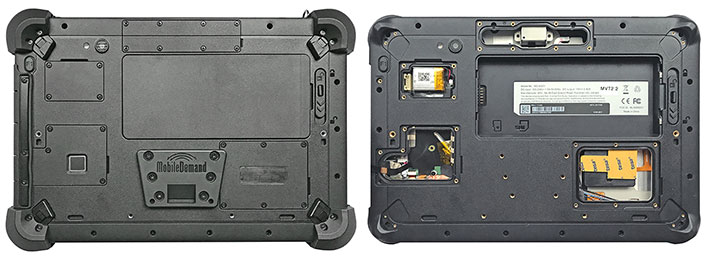
In terms of construction, the xTablet T1150 consists of a polycarbonate plastic housing with an internal magnesium chassis that's screwed onto the front part of the housing. Mounted on the chassis are the LCD on one side and motherboard, components and modules on the other. The front part of the housing is implemented as a shallow open box. The flat rear part is coffered in many areas for reinforcement, and the majority is painted silver.
Below you can see what the xTablet T1150 looks like inside:
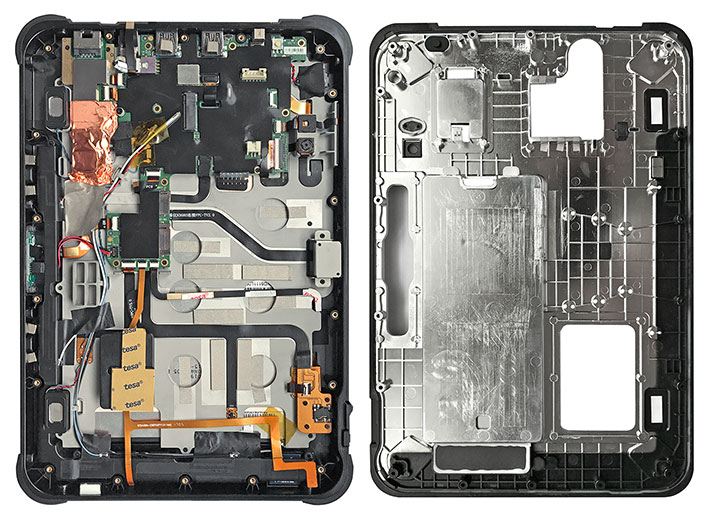
Sealing between the two parts of the housing is of a tongue-and-groove design, with a hard plastic lip on the front part of the housing pressing against a replaceable o-ring seal sitting inside a groove around the perimeter of the backplate.
 The 40 watt-hour rechargeable Li-Polymer battery of the T1150 fits flush into its compartment. The battery has its own friction seal, which is necessary as the battery compartment includes not only the battery terminal openings into the interior of the tablet, but also openings for the unit's microSD and micro SIM slots. The 40 watt-hour rechargeable Li-Polymer battery of the T1150 fits flush into its compartment. The battery has its own friction seal, which is necessary as the battery compartment includes not only the battery terminal openings into the interior of the tablet, but also openings for the unit's microSD and micro SIM slots.
The battery is secured in place with a spring-loaded lever that can be locked in place. The battery, which is hot-swappable, is unlikely to come loose during operation.
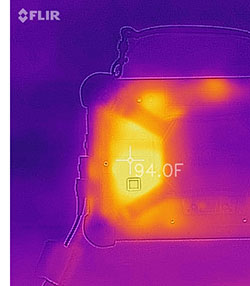 Unlike the interior of many Windows tablets, which are jam-packed full of electronics, the T1150 looks remarkably tidy inside. The main body of the motherboard measures a mere 3 x 4 inches, though it has a peninsula extension with the card slots and various ribbon cables emanating from it. Unlike the interior of many Windows tablets, which are jam-packed full of electronics, the T1150 looks remarkably tidy inside. The main body of the motherboard measures a mere 3 x 4 inches, though it has a peninsula extension with the card slots and various ribbon cables emanating from it.
There's a full-length mini PCIe slot. No other modules are in sight. Almost all I/O is edge-mounted on the little motherboard. This is a very highly integrated and very professionally executed design.
The interior layout is visually dominated by various miniaturized ribbon cables that connect the small motherboard to all the antennae, cameras, speakers, and other things mounted inside the T1150. What's impressive is that all these ribbon cables have their own shallow channels carved into the magnesium chassis. Even the tiny industrial-grade 1D/2D barcode reader has its own custom-cut nook in the metal chassis, and so have both the tiny documentation camera and its accompanying LED illuminator.
The colorful picture to the right was taken with our Flir One infrared camera. It shows the thermal situation inside the xTablet T1150, with darker areas the coolest and bright yellow the hottest. Since the xTablet T1550 doesn't have a fan to remove heat, good thermal management is essential. As can be seen, the area where the xTablet T1150's processor resides is hottest. In our performance benchmark testing, we measured a maximum surface temperature of about 94F, not even human body temperature.
As for as protection goes, each of the tablet's peripheral port openings has its own separate protective door with a friction seal. These individual port covers are actually all cut from one single piece of rubbery material, which can easily be replaced. For drop/bump protection, the plastic housing itself has a rubbery protective layer that goes around the entire perimeter of the tablet, and also has small integrated corner bumpers. These bumper areas contain anchors for larger protective bumpers that screw on. If the extra protection afforded by the heavy duty anchors is not needed, they can be taken off and the tablet can be used without them, making for a smaller footprint.
Shown below are a couple of interesting details of the xTablet T1150. On the left the tablet's tiny camera and LED illuminator snuggly sitting in their own cutouts in the metal chassis. In the middle the two-part protective corner bumpers that are individually replaceable. On the right a closeup of the T1150's tiny 1D/2D industrial grade barcode reader. Sure, there are smartphone apps that can read barcodes with the phone camera. Having a dedicated scanner is much faster and much more accurate.

The details below: On the left the slots for the tablet's micro SIM and micro SD card. So the battery must be removed to get at those slots ad they represent additional openings to the interior. Not ideal. On the right detail of the sealing design between the two housing halves. The seal is replaceable, not too complex, and should work well.

Overall, the insides of the xTablet T1150 show a complete PC stuffed into a small space, but much of the componentry and electronics have been miniaturized more like those in a consumer tablet. Quality seems high, with good fit and finish.
"Mid-performance"
The xTablet T1150 runs Windows 10 Professional on an Intel Atom X5-8550 processor. This is a quad-core "system-on-chip" processor of Intel's 14nm "Cherry Trail" lineup that succeeds the popular 22nm "Bay Trail" roster. 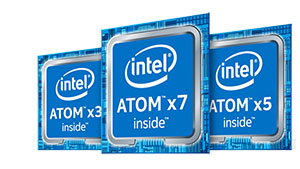 Integrated graphics are of the Intel Gen 8 variety, the same generation as Intel's high-end "Broadwell" 5th generation Core processors. Integrated graphics are of the Intel Gen 8 variety, the same generation as Intel's high-end "Broadwell" 5th generation Core processors.
Where does the X5 prefix come from? That's because having used the i3/i5/i7 prefixes in their more expensive Core processors to indicate good/better/best, Intel apparently wanted to apply that system to their Atom processors as well. So the X5-8550 chip in this xTablet would be a mid-range offering with more capabilities and features than an X3 CPU, but not quite as much as an X7-class processor.
As is, the table blow shows our benchmark results for the "Cherry Trail" X5-Z8550-based xTablet T1150, the X5-Z8350-based xTablet T1550 and Flex 10A, and, for comparison, MobileDemand's higher-end xTablet T1600 with its Intel 4th generation "Haswell" Core processor.
|
PassMark 6.1
|
MobileDemand
|
MobileDemand
|
MobileDemand
|
MobileDemand
|
|
Model
|
xTablet T1150 (2017)
|
xTablet T1550 (2017)
|
xTablet Flex 10A (2017)
|
xTablet T1600 (2015)
|
|
OS
|
Win 10 (64-bit)
|
Win 10 (64-bit)
|
Win 10 (64-bit)
|
Win 8.1 (64-bit)
|
|
Processor Type
|
Intel Atom
|
Intel Atom
|
Intel Atom
|
Intel Core
|
|
Processor Model
|
X5-8550
|
X5-8350
|
X5-8350
|
i5-4200U
|
|
CPU Speed
|
1.44GHz
|
1.44GHz
|
1.44GHz
|
1.60GHz
|
|
Max Burst Speed
|
2.40GHz
|
1.92GHz
|
1.92GHz
|
2.60GHz
|
|
Scenario Design Power
|
2 watts
|
2 watts
|
2 watts
|
NA
|
|
CPU Mark
|
1,669.1
|
1,642.2
|
1,599.7
|
2,488.7
|
|
2D Graphics Mark
|
96.7
|
99.8
|
96.3
|
365.1
|
|
Memory Mark
|
434.2
|
345.5
|
324.4
|
830.6
|
|
Disk Mark
|
802.6
|
642.9
|
615.9
|
2,985.5
|
|
3D Graphics Mark
|
235.3
|
142.4
|
109.7
|
387.9
|
|
Overall PassMark
|
731.3
|
665.2
|
640.1
|
1,516.2
|
|
CrystalMark
|
|
|
|
|
|
ALU
|
29,672
|
21,488
|
22,251
|
37,045
|
|
FPU
|
21,437
|
17,643
|
18,487
|
36,633
|
|
MEM
|
23,865
|
19,394
|
19,711
|
28,295
|
|
HDD
|
17,861
|
18,785
|
21,304
|
35,336
|
|
GDI
|
3,569
|
3,569
|
3,680
|
13,563
|
|
D2D
|
3,039
|
2,616
|
2,540
|
6,427
|
|
OGL
|
3,410
|
2,997
|
3,015
|
9,996
|
|
Overall CrystalMark
|
103,912
|
86,492
|
90,988
|
167,295
|
We wish MobileDemand's three 10.1-inch tablets would be a bit more differentiated in terms of their processors. Given their good, better, best positioning, that would make sense.
Even so, the choice of the X5-8550 in the T1150 instead of the X5-8350 used in the T1550 and Flex 10A helps the "best" T1150 eke out a slight but noticeable performance advantage over its lesser siblings (having quicker RAM helps, too).
As expected, there is a considerable performance difference between even the latest Intel Atom chips and the company's far more complex and also far more expensive Core processors.
Even though the last xTablet T1600 we tested came with the older Intel 4th generation Core i5-4200U instead of the 5th generation i5-5200U used in currently shipping units, it's still in a much higher performance league. That's in part due to the Core processor, but in part also by the higher mass storage performance of the T1600. The three Intel Atom-based tablets use comparatively slow eMMC onboard memory whereas the xTablet T1600 uses much quicker solid state mass storage technology.
And what about battery draw? Unfortunately, we didn't have time to run our usual BatteryMon power draw-down testing. As is, the Li-Polymer battery packs 40 watt-hours, which MobileDemand says is good for 8 hours.
Very good 1920 x 1200 pixel capacitive multi-touch display
While MobileDemand is increasingly making a name for itself for providing good rugged tablet technology at value prices, the company's cost-cutting to make those low prices possible has never come at the expense of features that matter most to their customers. If an inexpensive processor gets the job done, MobileDemand won't spend 15 times as much on a high-end Core processor. Makes sense. They will not, however, skimp when it comes to displays. A good display is crucial for work out there in the field.

So it's no surprise that the xTablet T1150 has a very good display. Measuring 10.1 inches diagonally it seems better suited to serious Microsoft Windows-based work than 7 or 8-inch tablet. It offers 1920 x 1200 pixel resolution in 16:10 wide-format. That's three times as many pixels as the 1024 x 768 XGA format that was commonly used in rugged tablets (even ones with larger screen sizes) for many years, and is still being used today.
On a 10.1-inch tablet screen, 1920 x 1200 translates into 224 points per inch (ppi), which is in the same range as Apple's"retina" MacBooks. That means even small text looks very sharp and crisp on the display. The xTablet T1150 uses 10-point projected capacitive multi-touch for effortless tapping, panning, pinching and zooming. While we've never been fans of capacitive touch on small screen Windows tablets, that's much less of an issue on a larger display like the T1150's, and Windows 10 is significantly better suited to capacitive touch than its predecessors.
In everyday use, the display works very well. The spec sheet claims 470 nits luminance. To put that in perspective, most standard laptops offer around 250 nits, iPads are generally in the 400 nits range, and displays specially built to use in sunlight may have over 1,000 nits. Subjectively, the T1150 screen is nice and bright, and very vibrant indoors. Outdoors, of course, perceived brightness depends on how bright it is outdoors on any given day and working condition.
The three pictures below show what you can expect from the T1150. The picture on the left was taken on a bright sunshiny day in the shade. That way, the display looks bright and offer very good contrast. The middle picture shows the impact of refection. Like almost all modern tablets, the T1150 has a glossy display surface. Depending on how the tablet is positioned, there will be reflections. The picture to the right shows the tablet reflecting the blue sky.

We cannot overemphasize how important a wide viewing angle is for a satisfying, non-disruptive viewing experience. Older and lesser display technologies are prone to often dramatic color and contrast shifts when viewed from different angles, something that we don't consider acceptable anymore. The xTablet T1150's display is immune to such shifts, which makes it a pleasure to use.

Bottom line here is that the T1150's designers did a good job selecting this display. One thing we weren't able to find out is whether there is an optional active digiter for this tablet. Those still come in handy for applications that require more precise control than is possible with fingers or a passive capacitive stylus.
Decent dual cameras
The xTablet T1150 has two integrated cameras. The user-facing 2mp camera is for video conferencing, whereas the rear-facing 8mp camera with LED flash can be used for documentation purposes.
Cameras integrated into handheld and tablet computers have historically underperformed compared to even low-end dedicated cameras and, more recently, the cameras available in virtually every smartphone. Things have gotten better on the built-in camera front, 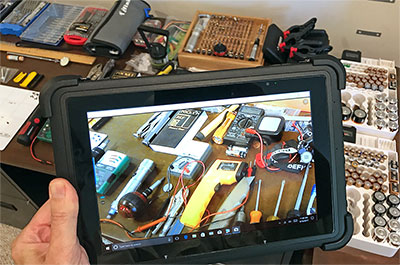 but usually not enough to eliminate the need of taking along a dedicated camera or smartphone if photo or video documentation is needed on the job. This remains a concern given that the cameras in leading smartphones are now capable of excellent picture and video quality. but usually not enough to eliminate the need of taking along a dedicated camera or smartphone if photo or video documentation is needed on the job. This remains a concern given that the cameras in leading smartphones are now capable of excellent picture and video quality.
As has already been the case during several recent tablet reviews, we couldn't fully examine the capabilities of the xTablet T1150 cameras. That's because the Windows 10 default imaging app only offers the most basic functionality, and so we couldn't test all the usual settings integrated cameras are doubtlessly capable of. System integrators and most customers will likely want more comprehensive software with all the usual settings.
In our testing, still images defaulted to 3264 x 1836 pixel, and video to 1920 x 1080 pixel in nominally 30 frames per second. In still photography, auto-focus worked fine, images were surprisingly crisp and sharp, and the camera does not over-compress images. Video was sharp enough for almost all purposes and did not lag behind. It pays to take time shooting pictures as there's a slight lag between pressing the shutter and the image being taken.
The front camera, though capable of 2-megapixel images, defaulted to 1280 x 720 pixel (720p). It worked more than well enough for conferencing.
Below are pictures shot with the xTablet T1150 documentation camera in 3264 x 1836 pixel resolution. That's less than 6 megapixel, but it is one of only two image sizes the (exceedingly basic) Windows 10 camera app provides. To see a full-size image of the compilation, click on the picture.

Like we already found in our testing of MobileDemand's T1550, the T1150's integrated documentation camera is suitable for most documentation tasks, both in still shots and in video. It's nice to have the big 10-inch screen as a viewfinder. Pictures actually come out a lot sharper than they appear on the screen.
We'd love to see MobileDemand include a more comprehensive camera app to truly bring out all the capabilities and features of the integrated cameras. Whether that still matters in this era of ubiquitous smartphones with their superior apps is up for discussion.
That's not all there is to say about the T1150's integrated cameras, though. MobileDemand literature suggests upcoming availability of a 3D camera option similar (or perhaps the same) as the 8-inch xTablet 8650 features. This would bring spatial awareness to the T1150, and that can be used for an emerging range of very interesting and productivity-enhancing 3D measuring applications.
Tough enough for most jobs
The major reason why customers opt for a rugged tablet is, obviously, ruggedness. The tablet must be able to handle the inevitable bumps and grinds and exposure on the job. What can you expect from the T1150, which represents the high end of MobileDemand's "value" lineup of rugged 10-inch tablets?
As far as the ever important drop spec goes, the T1150 exceeds the MIL-STD 810G, 516.6 IV gold standard that mandates 26 repeated drops to one operating unit onto plywood over concrete from 48 inches. Why 48 inches? Because if a tablet is dropped while it's being used in a standing or walking position, it'll drop about four feet. The xTablet T1150 can actually handle those drops from five feet. Kudos.
The operating temperature range is 14° to 122°F, which is much wider than the potentially restrictive 32° to 120°F range of the Flex 10A, but actually narrower than the T1550's -4° to 140°F. It's not immediately obvious why that would be the case, but 14° to 122°F still covers most potential applications out there.
The biggest difference between both the xTablet T1150 and T1550, and the Flex 10A is in the sealing of the units against the elements. Despite its protective casing and nicely implemented protective rubber plug for all I/O ports, the Flex 10A isn't considered a sealed unit and does not have an ingress protection rating. That means no working in the rain. The xTablet T1150 and T1550, on the other hand, carry a respectable IP65 rating. That means they're totally dustproof and can also handle low pressure water jets from all directions. That'll do for virtually all deployments.

Unfortunately, the current specs don't show much in terms of additional ruggedness information. Given that the T1150 is a rugged tablet and is sold as one, we'd like to see more comprehensive testing results.
Mounting and docking options
Most tablets used in business or on the job come with some kind of docking and mounting options, and the xTablet T1150 is no different. Available are a desktop docking station, a vehicle dock, and very handy quick-release mounting options.

We had a chance to test the available heavy-duty RAM Mount setup and loved it. Flimsy mounting options can be quite frustrating due to vibrations and flex. No such problems with this setup. Super-easy to adjust any which way (see below), and absolutely solid as a rock. Highly recommended.

Bottom line: MobileDemand xTablet T1150
With the xTablet T1150, MobileDemand adds a third option to its 10-inch rugged tablet lineup. The T1150 represents the top-of-the-line among the trio (the other two being the low-end Flex 10A and the mid-range T1550), offering additional refinement and performance as well as options not available in the lower-end products.

Like its T1550 sibling, the xTablet T1150 was designed from the ground up as a rugged tablet. It can be equipped with an integrated industrial-grade scanner, NFC/RFID, dedicated PS, as well as a 3D camera option for an emerging range of productivity-enhancing 3D measuring applications.
 Weighing in at just under three pounds as tested, MobileDemand's xTablet T1150 provides an attractive proposition for customers who want the convenience and ease of use of a 10-inch class tablet in package that's well-equipped and well-protected but costs less than premium rugged tablets.
Weighing in at just under three pounds as tested, MobileDemand's xTablet T1150 provides an attractive proposition for customers who want the convenience and ease of use of a 10-inch class tablet in package that's well-equipped and well-protected but costs less than premium rugged tablets.
The tablet's quad-core Intel "Cherry Trail" processor is basic but provides more than adequate performance (more than twice that of MobileDemand's flagship T8700 tablet of just a few years ago).
The xTablet T1150 impresses with an crisp, sharp, bright and vibrant 10.1-inch 1280 x 800 pixel display with perfect viewing angle from all directions and no color or contrast shifts.
Its 10-point capacitive multi-touch screen is quick and very responsive, and works very well with Windows 10 and touch-optimized applications.
Onboard connectivity including full-size USB 2.0 and 3.0 ports, micro-HDMI, and an RJ45 LAN jack. The 2mp and 8mp cameras are suitable for conferencing and documentation. There is a user-accessible and replaceable hot-swappable battery.
The tablet's rubber and polycarbonate casing is well designed and of high quality. Protective bumpers and port plugs are effective and can easily be replaced. The tablet is well sealed, can survive steep drops unharmed, and the operating temperature range of the tablet is wide enough for virtually any application.
All of this makes the fanless xTablet T1150 a compelling package for anyone who needs Windows on tough jobs, even those that require high-level sealing, high resolution, GPS, and industrial-grade scanning.
-- Conrad H. Blickenstorfer, September 2017
MobileDemand xTablet xTablet T1150
| Type
|
Rugged tablet computer
|
| Added |
Full review 09/2017
|
| Processor |
Quad-core Intel "Cherry Trail" Z8550
|
| Processor speed |
1.44GHz, 2.40GHz burst frequency
|
| Scenario Design Power |
2 watts |
| Display Chipset |
Intel HD 400, 200-500MHz
|
| OS |
Windows 10 Professional (64-bit) |
| Memory |
4GB LPDDR3-1600 |
| Display |
TFT LCD |
| Display size/res |
10.1-inch, 1920 x 1200 pixel, 470 nits
|
| Digitizer |
10-point capacitive multi-touch, optional digitizer |
| Keyboard |
Onscreen keyboard + optional external
|
| Storage |
64GB eMMC |
| Expansion slots |
1 x micro SDXC card, 1 x microSIM |
| Housing |
Polycarbonate housing with integrated and replaceable protective rubber bumpers, magnesium internal frame |
| Size |
11.6 x 7.56 x 0.87 inches (295 x 192 x 22 mm)
|
| Weight |
2.92 lbs. as tested with battery and handstrap (1.32kg)
|
| Operating temperature |
14° to 122°F (-10° to 50°C)
|
| Ingress protection |
IP65
|
| Drop/shock |
MIL-STD 810G, 516.6 IV: 26 repeated drops to one operating unit onto plywood over concrete from 60 inches, 225g ball drop to screen w/ protector from 100cm
|
| Tumble |
Unknown
|
| Vibration |
Unknown
|
| Power |
Rechargeable, replaceable 3.7V 10,800mAH 40 watt-hour Li-Polymer ("8 hrs")
|
| Cameras |
2mp camera front, 8mp AF camera with LED flash rear; optional 3D camera |
| Sensors |
9 Axis MEMS sensor (gravity acceleration, eCompass, gyroscope), ambient light, proximity
|
| Interface |
1 x USB 3.0, 1 x USB 2.0, 1 x micro HDMI, 1 x RJ45 LAN, headphone jack, power, docking |
| Wireless |
802.11 a/b/g/n/ac WiFi, Bluetooth 4.0, optional: GPS, NFC/RFID, 1D/2D barcode reader, 4G LTE (Sierra Wireless EM-7455)
|
| Price |
Starting at US$1,445
|
| Warranty |
1 year warranty with extended warranty and extended service plans available
|
| Regulatory |
FCC, CE, and IC
|
| Web |
MobileDemand xTablet T1150 web page |
| Contact |
MobileDemand xTablet T1150 specs (PDF) |
(copyright 2017 RuggedPCReview.com)
|




